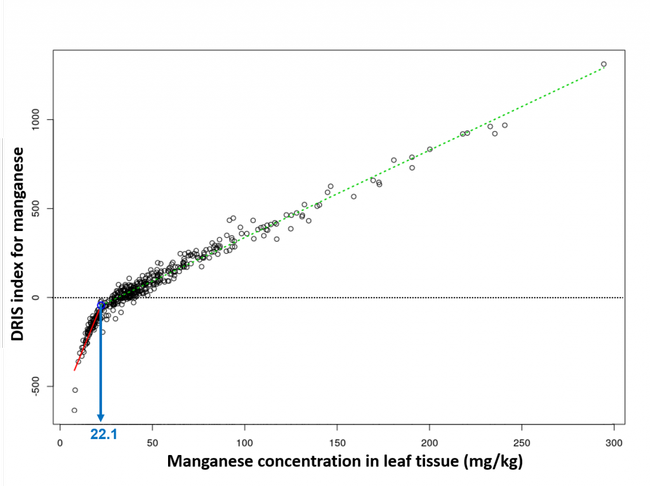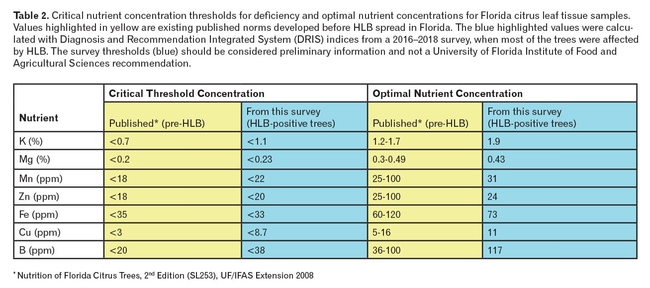Critical Leaf Nutrient Thresholds to Diagnose Deficiencies in HLB Trees
By Arnold Schumann, Laura Waldo, Tripti Vashisth, Alan Wright and Kelly Morgan
Huanglongbing (HLB) disease severely impacts the nutrient status of citrus trees, particularly by stunting the feeder roots and causing measurable deficiencies of nutrients in the roots and canopies. Visible symptoms of nutrient deficiencies on citrus foliage are characteristic but not diagnostic of HLB disease.
Recent HLB research efforts have focused on manipulating nutrient deficiencies with fertilizer applications to mitigate HLB symptoms and help keep affected trees alive and productive. Efficient diagnosis of nutrient imbalances in HLB-affected trees (both deficiencies and excesses) is necessary to make fertilizer remedies cost-effective and productive. Published thresholds defining deficient, low, optimal, high and excess ranges of nutrient concentrations in citrus leaves were derived long before HLB spread in Florida. Therefore, we conducted a series of survey studies to verify and improve those existing thresholds in HLB-endemic Florida citrus groves.
Traditionally, nutrient thresholds were obtained empirically from long-term replicated fertilization trials conducted decades ago, most notably where “missing nutrient” experiments would, over many years, cause those nutrients to become deficient in trees not receiving certain fertilizers. By comparing treatment plots to fully fertilized control plots, the fruit yield reduction and other symptoms caused by the nutrient deficiency could be quantified.
Critical threshold concentrations (CTCs) derived for each nutrient from those studies were then published and used as thresholds to diagnose leaf tissue samples collected from commercial groves. In the current study, we used a sample survey method and the Diagnosis and Recommendation Integrated System (DRIS) instead of “missing nutrient” experiments in order to save considerable time.
STUDY SETUP
Leaf tissue samples were collected quarterly from 2016 to 2018 in three citrus-growing regions of Florida (11 locations from the Central Ridge, five from the east coast Indian River and six from the southwest Flatwoods). Soil samples were collected annually, and tree canopy measurements, leaf size, starch content, quantitative polymerase chain reaction (qPCR) assay and other measurements were conducted periodically for the same sites. In this article, we will focus only on the leaf tissue nutrients of sweet orange trees and assume that most of the sampled trees were HLB-positive, based on the qPCR analyses.
ABOUT DRIS
In an April 2009 Citrus Industry article, DRIS was introduced as a promising method for interpreting nutrient levels in plant tissues. See “Potential use of DRIS for leaf nutrient diagnosis in Florida citrus” (www.crec.ifas.ufl.edu/extension/trade_journals/trade_journals2009.shtml).
The DRIS method produces an index for each plant nutrient calculated from a series of leaf concentration ratios of that nutrient with all other measured nutrients, relative to a set of nutrient norms (standards) that were previously calculated from a high-yielding grove. We obtained the DRIS norms from leaf samples collected in the summer of 2003, from a 22-year-old block of Hamlin orange trees on Cleopatra mandarin rootstock near Fort Meade, Florida, spaced 20 by 25 feet and with an average fruit yield over four years of 770 boxes per acre. The leaf sampling for DRIS norm development coincided with a peak yield of 970 boxes per acre in the 2003–04 season, prior to Hurricane Charlie and the appearance of HLB in Florida.
DETERMINING DEFICIENCIES
The application of DRIS to diagnose nutrient deficiencies in leaf tissue from HLB-affected trees is best done in conjunction with the CTCs. The CTCs are the thresholds for each nutrient that determine whether a given tree or grove would be responsive to fertilizer supplying that nutrient. Traditionally the CTCs occupy a spot on the plant response curve for each nutrient concentration of about 90 percent maximum yield or growth.
When multiple deficiencies occur, as is often the case with HLB-affected trees, the DRIS indices provide information about the relative severity and ranking of the deficiencies, which the CTCs do not accomplish. Dealing with multiple nutrient deficiencies efficiently is important because of the biological stoichiometry that determines the ideal proportions of nutrients in a plant, just as, for example, a water molecule consists of exactly two atoms of hydrogen and one of oxygen.
Liebig's law of the minimum applied to plant growth, and often visualized as a leaking barrel, (Figure 1) demonstrates that it is the most limiting nutrient that limits growth and yield, regardless of the amounts or types of other nutrients available. Another analogy is that a gasoline engine will not run faster if only the gasoline flow is increased without proportionately increasing the air (oxygen) supply, such as if the choke control is active. The engine may flood and stall if too much gasoline is supplied without increasing the most limiting ingredient for combustion at that time (oxygen).
For example, consider the results in Table 1 of leaf tissue analysis from an HLB-affected tree.
DRIS indices have a theoretical optimum at zero, with more negative values indicating possible nutrient deficiency, and increasing positive values indicating possible nutrient excess. In the Table 1 example, Mg<Mn
Figure 1. Scatter plot of leaf manganese Diagnosis and Recommendation Integrated System (DRIS) indices versus manganese concentrations in HLB-affected citrus. The breakpoint between red and green regression lines indicates the location of the critical threshold concentration (CTC = 22.1 mg/kg).
CALCULATING CTCs
To examine the validity of currently available CTCs for nutrient diagnosis in HLB-endemic Florida citrus, we used scatter diagrams of the DRIS indices for each nutrient plotted against the nutrient concentrations. This technique has been used before in other crops to determine CTCs from nutrient survey data, including loblolly pine, cotton and signalgrass. Figure 2 shows that the scatter plot for manganese in our survey of HLB-affected groves follows two data trends of different slopes, with the breakpoint indicating the CTC for that nutrient on the x-axis. We used segmented linear regression to determine the correct breakpoint.
The process was repeated for each nutrient in order to determine the preliminary CTCs listed in Table 2. The optimal nutrient ranges in Table 2 were estimated from the intercept of the regression line with zero on the y-axis (DRIS). By comparing our new CTCs with published CTCs, it appears that deficiency diagnoses for copper, boron, potassium, manganese and zinc could be underestimated by currently available CTCs when used for HLB-affected trees.
The optimal nutrient concentrations calculated from this study are mostly in agreement with ranges previously published by the University of Florida Institute of Food and Agricultural Sciences (UF/IFAS), except that boron and potassium optimal levels were estimated slightly higher in the survey than those previously published. These results are preliminary, and in this study, CTCs could only be calculated for those nutrients where deficiencies occurred in the survey data. We plan to augment this survey with more leaf nutrition data to better define and expand CTC estimates to be used for diagnosing HLB-affected citrus for all nutrients.
Please contact us if you have leaf nutrient data from your groves that you are willing to share in this study, or if you would like to use the DRIS program which will be published online to a UF/IFAS web page.
SUMMARY
In this article we provided updates on research efforts to improve the nutrition of HLB-affected Florida citrus by revising the diagnostic CTC of nutrients in leaf tissue. We also revisited the DRIS method for improving diagnosis of multiple nutrient deficiencies that are common in HLB-affected groves, including potassium, magnesium, manganese, zinc, iron, boron and copper. Additional leaf nutrient data will be obtained for an expanded survey, to be analyzed and corroborated with results of recently completed micronutrient fertilization experiments.
Acknowledgements: We thank the grower cooperators who offered their groves for our nutrient surveys, including Gapway Groves, Ben Hill Griffin Groves, OrangeCo, Brent Shirard, Michael Monroe and English Brothers. We are grateful to the Citrus Research and Development Foundation for financial support of this project.
Arnold Schumann (schumaw@ufl.edu) and Laura Waldo are soil scientists, and Tripti Vashisth is a horticulturist, all at the UF/IFAS Citrus Research and Education Center in Lake Alfred. Alan Wright is a soil scientist at the UF/IFAS Indian River Research and Education Center in Fort Pierce. Kelly Morgan is a soil scientist and center director at the UF/IFAS Southwest Florida Research and Education Center in Immokalee.
Table 1. Leaf tissue analysis of HLB-affected orange trees
Figure 1. Manganese concentration of leaf tissue
Table 2. Critical nutrient concentration thresholds
Attached Images:


